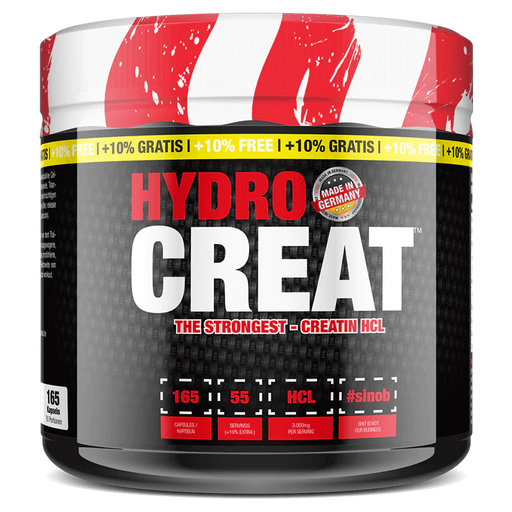Creatin HCL
Filter
-
 Jetzt 11% sparen
Jetzt % sparen
Original-Preis €38,90Original-Preis €38,90 - Original-Preis €38,90Original-Preis €38,90Aktueller Preis €34,62€34,62 - €34,62Aktueller Preis €34,62|/
Jetzt 11% sparen
Jetzt % sparen
Original-Preis €38,90Original-Preis €38,90 - Original-Preis €38,90Original-Preis €38,90Aktueller Preis €34,62€34,62 - €34,62Aktueller Preis €34,62|/Hydro Creat Creatin HCl · 165 Kapseln
#sinob1 reviewPraktische Kapselform: Ideal für unterwegs und einfache Dosierung mit 1.000mg Creatin HCL pro Kapsel. Steigerung der Leistungsfähigkeit: Erhöht...
Vollständige Details anzeigenOriginal-Preis €38,90Original-Preis €38,90 - Original-Preis €38,90Original-Preis €38,90Aktueller Preis €34,62€34,62 - €34,62Aktueller Preis €34,62|/Jetzt 11% sparen Jetzt % sparen
Die Effektivität von Kreatin für den Aufbau von Kraft und Muskelmasse wurde im Rahmen klinischer Studien wieder und wieder bewiesen. Folglich handelt es sich bei Kreatin um ein absolutes MUSS für Bodybuilder, Gewichtheber und andere Sportler. Im Bereich der Kreatinforschung werden kontinuierliche weitere Fortschritte bezüglich der Verbesserung dieses Wirkstoffes gemacht und einer dieser aufstrebenden neuen Stars ist Kreatin Hydrochlorid (kurz Kreatin HCL).
Was ist Kreatin HCL?
Wie der Name bereits nahelegt, wird Kreatin HCL durch die Anbindung einer HCL Gruppe an das Kreatinmolekül hergestellt, wodurch ein Kreatinsalz entsteht. Durch das Anhängen der Hydrochlorid Gruppe wird die Löslichkeit des Moleküls im Vergleich zu Kreatin Monohydrat (die Grundform von Kreatin) stark verbessert. Dies resultiert in verbesserten Qualitäten im Vergleich zum bereits hervorragenden Kreatin Monohydrat.
Kreatin Monohydrat vs. Kreatin HCL
Kreatin HCL ist die am besten lösliche auf dem Markt erhältliche Kreatinform. Als Resultat hiervon kann Kreatin HCL im Vergleich zu Kreatin Monohydrat eine höhere Bioverfügbarkeit und eine schnellere und bessere Absorption aufweisen Dies bedeutet, dass Kreatin HCL im Grunde genommen eine super konzentrierte Form von Kreatin ist und dass nur eine sehr viel geringere Dosierung notwendig ist, um dieselben Resultate bezüglich Kraft- und Muskelzuwächsen zu erzielen. Darüber hinaus benötigt man nur eine geringe Menge an Flüssigkeit und muss deshalb bei der Kreatineinnahme keine großen Flüssigkeitsmengen trinken.
Auch wenn es nicht häufig vorkommt, verspüren einige Menschen leichte Nebenwirkungen wie ein Aufblähen, Krämpfe und häufigen Harndrang, wenn sie Kreatin Monohydrat verwenden. Diese Nebenwirkungen sind gesundheitlich völlig unbedenklich, können jedoch als störend empfunden werden. Von Kreatin HCL wird berichtet, dass solche Nebenwirkungen nicht auftreten.
Für eine maximale Effizienz von Kreatin Monohyrat wird häufig eine sogenannte Ladephase empfohlen, während der große Mengen an Kreatin (20 Gramm pro Tag) konsumiert werden. Aufgrund der höheren Bioverfügbarkeit und der besseren Absorption von Kreatin HCL ist eine solche Ladephase nicht notwendig Darüber hinaus ist bei Kreatin HCL auch keine zyklische Einnahme notwendig.
Kreatine HCL Forschung
Dieses Produkt wurde vor nicht allzu langer Zeit im Jahr 2009 patentiert. Da es sich um ein noch relativ neues Produkt handelt, hatten die meisten Sportwissenschaftler noch nicht die Gelegenheit Studien mit diesem Wirkstoff durchzuführen. Im Jahr 2009 wurde jedoch ein Artikel über die Effizienz von Polyethylene Glycosylated Creatine Hydrochloride (PEG Kreatin HCL) veröffentlicht, der zeigte, dass eine geringe Dosis PEG Kreatin HCL (1,25g) eine ähnlich starke leistungssteigernde Wirkung wie eine deutlich höhere Dosis Kreatin Monohydrat (5g) hatte. PEH Kreatin HCL ist eine modifizierte Version von Kreatin HCL und ist zurzeit auch auf dem Markt erhältlich. Auch wenn im Augenblick keine mit Kreatin HCL durchgeführten Studien verfügbar sind, könnten die Resultate der PEG Kreatin HCL Studie auf reguläres Kreatin HCL übertragbar sein, da die Vorzüge dieser beiden Verbindungen ähnlich sind.
Feedback von Kreatine HCL Anwendern
Es ist schwer die große Menge an positivem Feedback von Kreatin HCL Anwendern zu ignorieren. Selbst ohne veröffentlichte wissenschaftliche Untersuchungen mit diesem Produkt war dieses Feedback zu erwarten, da das diesem Produkt zugrundeliegende Grundprinzip schlüssig aussieht. Personen, die Kreatin HCL ausprobiert haben, bestätigen in der Tat reduzierte Nebenwirkungen sowie Zuwächse an Kraft, Muskelmasse und Energie. Es dürfte nicht allzu lange dauern, bis die Wissenschaft aufschließen und die Vorzüge von Kreatin HCL klinisch bestätigt wird.
Nachteile von Kreatin HCL
Die einzige Beschwerde, die man im Feedback von Anwendern findet, sind die relativ hohen Kosten einer Kreatin HCL Supplementation im Vergleich zu Kreatin Monohydrat. Auch wenn ein Gramm Kreatin HCL von seiner Wirkung her 5 Gramm Kreatin Monohydrat entspricht, ist Kreatin HCL immer noch vergleichsweise teuer. Dies ist jedoch bei neuen bahnbrechenden Produkten zu erwarten und die Preise könnten in der Zukunft fallen.
Einnahmeempfehlung
Anders als bei Kreatin Monohydrat benötigt man nur ein Gramm Kreatin HCL pro Tag. Um die Absorption zu erhöhen, sollte es am besten mit einem zuckerhaltigen Getränk wie Saft oder als Teil des Shakes nach dem Training eingenommen werden.
Kreatine HCL Supplements
Kreatin HCL ist als Monopräparat erhältlich, welches man, falls man zurzeit kein Pre-Workout Supplement verwendet, etwa eine Stunde vor dem Training einnehmen kann, um dabei zu helfen, das Trainingspotential zu erhöhen.
Alternativ ist Kreatin HCL auch als Teil von Pre-Workout Supplements erhältlich, welche neben Kreatin HCL weitere Inhaltsstoffe wie Koffein enthalten, die bei der Zufuhr zusätzlicher Nährstoffe hilfreich sein können und darüber hinaus weitere Vorzüge zusätzlich zu den Vorzügen von Kreatin HCL bieten können.
Ähnlich wie Kreatin Monohydrat kann Kreatin HCL auch als Post-Workout Supplement oder als Teil einer Post-Workout Mischung verwendet werden, um die Pre- und Intra-Workout Supplementation zu vervollständigen und die Regeneration zu unterstützen.
Kombination mit anderen Supplements
Kreatin HCL kann mit anderen Kreatinformen wie Kreatin Monohydrat kombiniert werden. Alternativ kann es auch anstelle von Kreatin Monohydrat verwendet werden. In diesem Fall wird Kreatin HCL zusammen mit Protein zu einem fundamentalen Supplement, das mit jedem anderen Supplement kombiniert werden kann, um die individuellen Ziele zu erreichen.
Fazit
Kreatin HCL ist ein Produkt, das auf jeden Fall einen Versuch wert ist. Die stärksten Argumente für Kreatin HCL sind die verbesserte Bioverfügbarkeit und die Eliminierung von Nebenwirkungen im Vergleich zu Kreatin Monohydrat. Auch wenn Kreatin HCL teurer als Kreatin Monohydrat ist, können diese Vorzüge Kreatin HCL zu einem attraktiveren Produkt machen, was insbesondere bei Menschen zutreffen dürfte, die bei der Verwendung von Kreatin Monohydrat unter Nebenwirkungen leiden.
Referenzen:
- Herda et al (2009), Effects of creatine monohydrate and polyethylene glycosylated creatine supplementation on muscular strength, endurance, and power output. J Strength Cond Res, 23: 818-826

